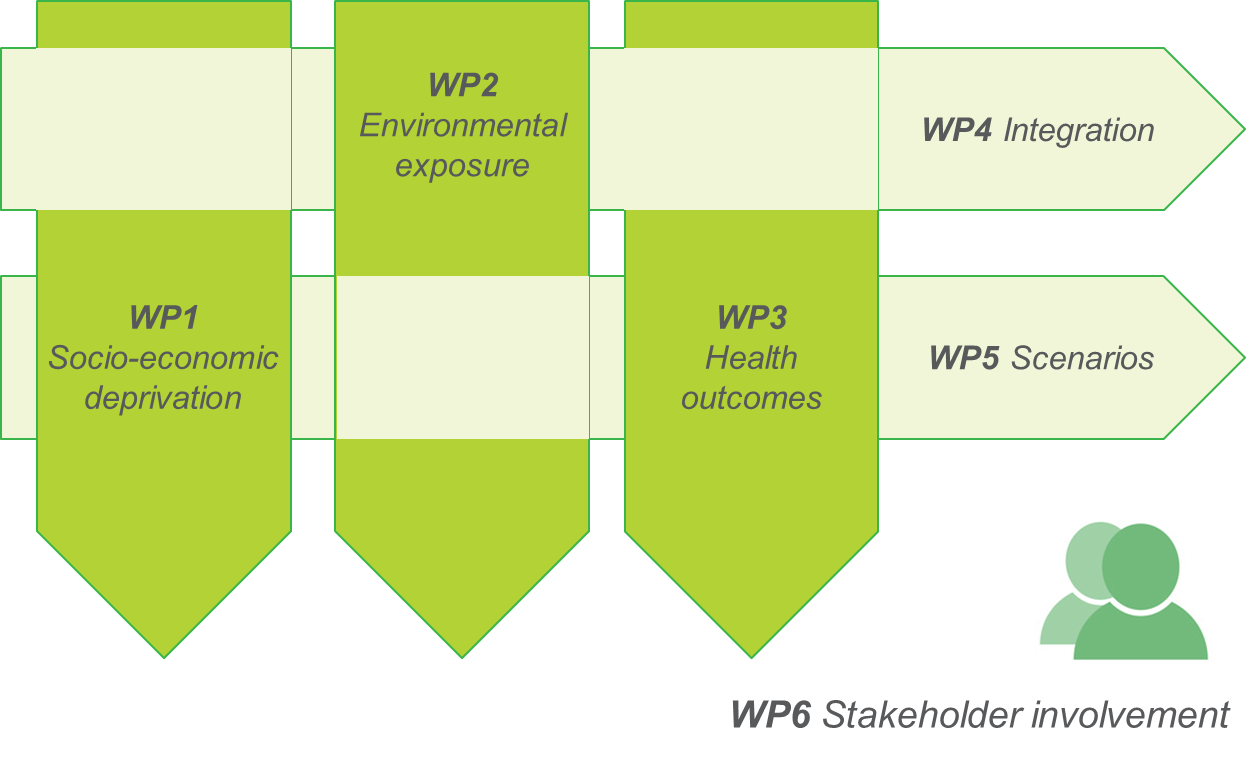Overall structure
To achieve the objectives of ELLIS, we define 6 work packages. WP1-3 will develop each of the three dimensions of environmental health inequalities. WP4 will develop the methodology for integrating them, while WP5 will establish the scenarios for health impact assessment. WP6 will ensure close and explicit interaction with the relevant stakeholders.

WP1. Socioeconomic deprivation
While most studies focus on a single socioeconomic indicator, mainly the education level and the socio-professional category, ELLIS aims to develop a more comprehensive Index of Multiple Deprivation (IMD), and implement this at the level of the statistical sector.
WP1 comprises five tasks:
- Literature review on the development and use of IMDs. Particular attention will be paid to the variables used to measure deprivation, the statistical methods used to construct the indices, and the impact of choosing the spatial scale required to measure the association between mortality and deprivation at the aggregate level.
- Analysis of the availability and quality of socioeconomic and demographic data at the level of Belgian statistical sectors.
- Construction of IMD indices at the individual level and at the level of statistical sectors.
- Exploration of spatial smoothing techniques to derive robust estimates of deprivation for sectors with small populations.
- Calculation of the Belgian IMD per statistical sector for the period 1991-2016.
WP2. Environmental exposure
People are simultaneously exposed to chemical substances, biological or physical agents, and other environmental stressors. Exposure to environmental pollution tends to cluster in given neighborhoods with a significantly higher number of inhabitants with a lower socioeconomic position. The relation also depends on the geographical scale of the analysis.
WP2 comprises 5 tasks:
- Literature review on environmental stressors, their measurement, availability and potential impact on individuals (health and causes of death).
- Mapping the exposure to environmental stressors at the level of statistical sectors in Belgium, taking into account the population density and distribution within the statistical sector. Possible stressors may include air pollution, noise, extreme heat days and absence of recreational or green areas; but will be defined through stakeholder consultation (see WP6).
- Analyzing the spatial variability of environmental stressors in order to:
- ... identify co-occurrence of specific environmental burdens and;
- ... detect hotspots of environmental inequalities related to health.
WP3. Health outcomes
A large number of health outcomes have been associated with exposure to environmental stressors. The activities of WP3 will focus on deriving data on these outcomes at the level of the statistical sector. Different data sources, each providing different advantages and disadvantages for achieving this goal, will be explored. Geospatial modelling techniques will be applied to smooth or extrapolate across statistical sectors, building on methods recently developed by our group. The framework of the Belgian National Burden of Disease Study will be used to translate health outcome data into Disability-Adjusted Life Years.
WP3 comprises 4 tasks:
- Literature review on environmental burden of disease at national and international level.
- Mapping of mortality and cause of death data per statistical sector.
- Mapping of health insurance data per statistical sector.
- Mapping of Health Interview Survey data per statistical sector.
WP4. Integration

The starting point of the integration process will be the mapping of each of the three dimensions at the level of the statistical sector, as conducted in WP1-3 (left panel). Then, a first integration step (A) will combine environmental exposure (e.g., air pollution) and health outcomes (e.g., overall mortality) into estimates of environmental burden of disease (EBD) (e.g., mortality attributable to air pollution), again at the level of the statistical sector (middle panel). Finally, in integration step B, environmental health inequalities will be defined as socioeconomic inequalities in EBD. To this end, the information on deprivation and EBD, each at statistical sector level, will be combined into a suite of pairwise and population-level measures of inequality, such as the concentration index (right panel). To support the validity of the proposed integration framework, potential biases due to ecological fallacy will be evaluated by comparing the individual-level and aggregate level analysis.
Environmental burden of disease
Integration of the environment and health dimensions will be done using a comparative risk assessment approach. This approach combines exposure data with relative risk functions to generate a Population Attributable Fraction (PAF), which reflects the proportion of the disease burden that is associated with the exposure. In its most generic form, PAF is given by:

where P(x) is the distribution of exposure, and RR(x) the relative risk function, describing the likelihood of an adverse health outcome occurring in function of exposure level. Information on relative risks for the selected stressors will be obtained from international literature. Since both exposure and health dimensions will be available at the level of the statistical sector, EBD estimates will also be obtained at the same level. For each statistical sector, we will thus obtain an estimate of socioeconomic deprivation and EBD, which will be integrated in the next step.
Inequality indices
To calculate socioeconomic differences in environmental exposure and environmental health, we will calculate a suite of inequality indices. Simple pairwise indicators, such as rate differences or rate ratios, compare the highest and lowest IMD categories, while complex indicators, such as the concentration index, relative and slope index of inequality, or attributable fraction, measure inequality across all IMD categories. We have recently shown that a panel of inequality indicators is required, since each individual index is on its own insufficient. Through WP6, we will interact with the stakeholders to explain the differences and implications of each of these indicators, and jointly arrive at a policy-relevant suite of indicators to be used in ELLIS.
Development of the ELLIS tool
All analyses will be performed in R, a free software environment for statistical computing and graphics (https://www.r-project.org/). R offers an increasingly wide range of options for dealing with geospatial data and for performing geospatial analyses, and furthermore allows programming the necessary functions for calculating EBD and the different inequality indices. The computational core of ELLIS will be made available for free and open access, using the GitHub platform (https://github.com/). The user interface of ELLIS will be developed as an online R Shiny application (https://shiny.rstudio.com/).
Ecological bias
The integration of the three dimensions will take place at the aggregate level, more specifically at the level of the statistical sector (i.e., the smallest administrative subdivision of Belgium). Because such aggregate-level analyses can be affected by ecological bias, we aim to assess the validity of the use of the statistical sector through analyzing health outcomes at the individual level. We will use hierarchical generalized linear models and investigate the effect of individual characteristics that are not included in the aggregate approach, such as lags between exposure and deaths, migration status and the household composition. Potential biases due to ecological fallacy will be evaluated by comparing the individual-level and aggregate level analysis.
WP5. Scenarios
The resulting ELLIS tool will allow estimating the health impact of various policies in a straightforward and consistent way. Indeed, ELLIS will allow modelling changes in environmental exposures, and the consequent impact on environmental inequalities, environmental health, and environmental health inequalities. International literature will be used to model the potential change in environmental exposure associated with a certain policy measure.
To model the impact on environmental health (environmental burden of disease) under the alternative exposure scenario, we will calculate the Potential Impact Fraction (PIF), i.e., the proportional change in disease risk after a change in the exposure of a related risk factor:

where P(x) and RR(x) are as before, and P'(x) reflects the exposure distribution under the alternative scenario. The burden under the alternative scenario is then given by the burden under the business-as-usual scenario times (1-PIF).
WP5 comprises 3 main tasks:
- Literature review of the potential impact of policy scenarios on environmental exposure.
- Development of the ELLIS module for health impact assessments and scenario analyses. The HIA and scenario analysis module will be integrated in the online tool described above, allowing stakeholders to assess in an interactive way the impact of possible policies.
- Per scenario, model changes in environmental exposures, and the consequent impact on environmental inequalities, environmental health, and environmental health inequalities.
WP6. Stakeholder involvement
The aim of this transversal WP is to ensure a close interaction with the relevant federal stakeholders to support effective translation of the modeled policy options into actions. A key output of these discussions will be the choice of environmental stressors as well as the choice and specifics of possible intervention measures.
A follow-up committee will be established at the beginning of the project, comprising representatives of the concerned federal authorities and experts in the field of environmental health inequalities. In addition to periodic follow-up meetings, we foresee the following three specific workshops with the follow-up committee:
- Current knowledge of environmental health inequalities in Belgium and discussion of feasibility and acceptability of possible mitigation measures.
- Presentation and discussion of health impact assessment methodology as a means to predict the possible impact of alternative policy options.
- Presentation and discussion of the main results of the ELLIS project on the extent of environmental health inequalities and the potential effect of mitigation measures.
The organization, preparation and facilitation of each of these workshops will be supported by the development of an issue brief or policy brief. Briefs are accessible and concise (e.g., 1-2 pages) documents that are important communication tools for bridging the gap between knowledge, awareness and policy. Issue briefs raise specific issues, e.g., the relevance of environmental stressors as a public health problem in Belgium, or the appropriateness of health impact assessment as a means to support decision-making; the development of these issue briefs will be supported by the literature reviews conducted in the context of the other WPs. Policy briefs provide suggested options for policy change, e.g., based on the overall outcomes of our project.


